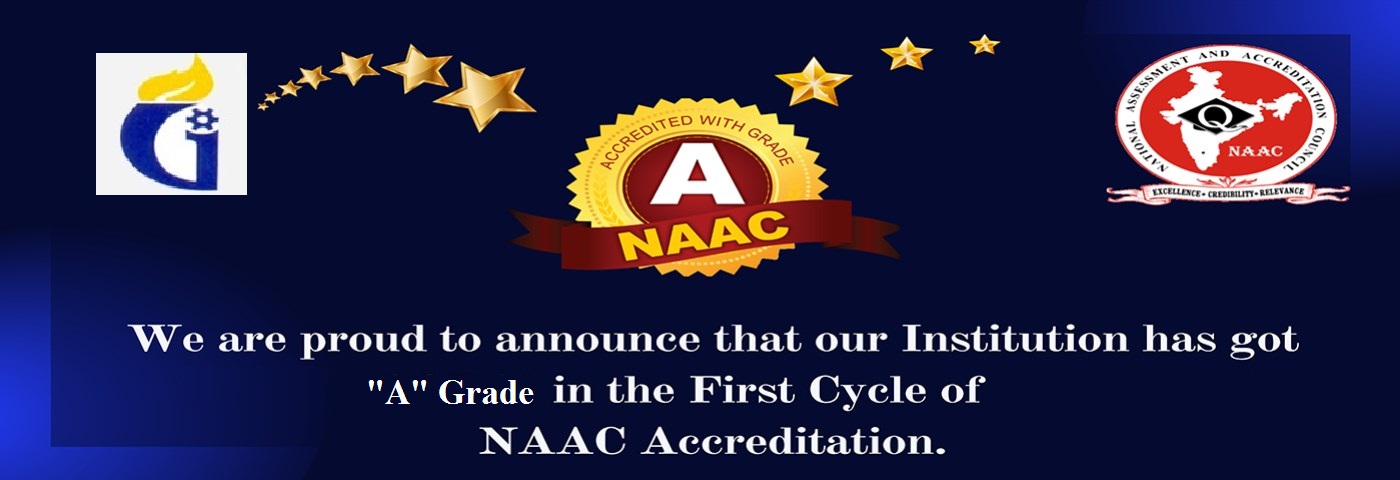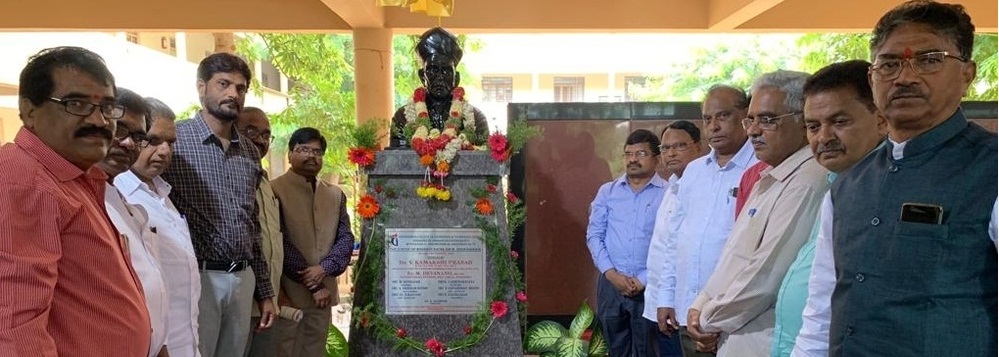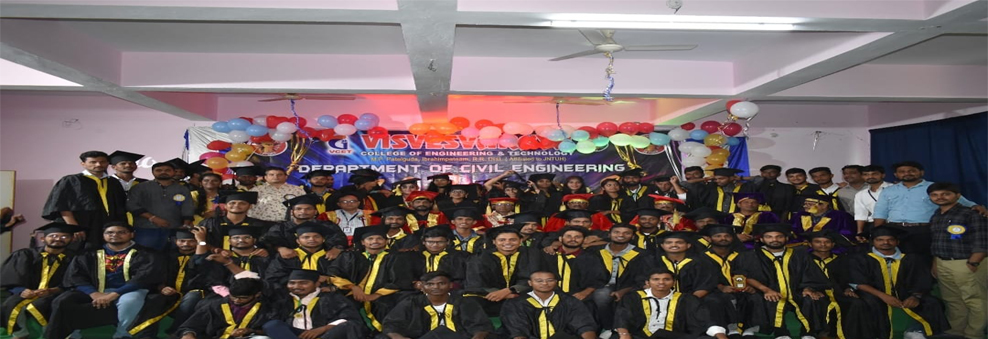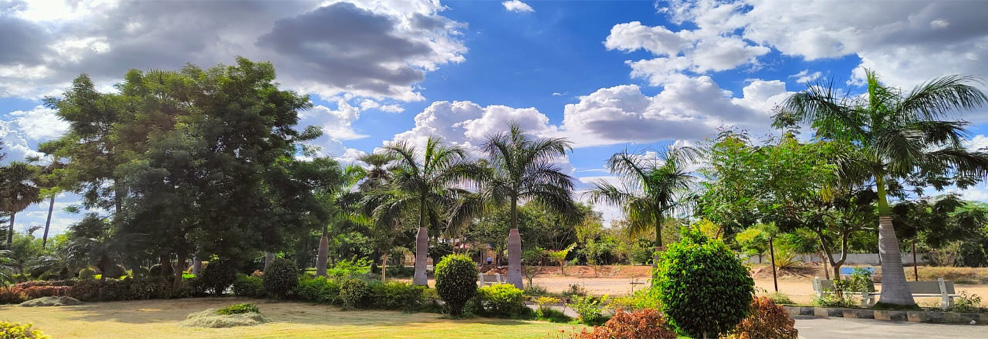Department of Mechanical Engineering
Course Outcomes (CO)
MECHANICAL ENGINEERING COURSE OUTCOMES FOR THE ACADEMIC YEAR 2021-2022. |
|||
S.No |
Year/ Sem |
Course Name |
Course Outcomes |
1 |
II-I |
MECHANICS OF SOLIDS |
CO.1 Analyze the behavior of the solid bodies subjected to various types of loading; |
CO.2 Apply knowledge of materials and structural elements to the analysis of simple structures; |
|||
CO.3 Undertake problem identification, formulation and solution using a range of analytical methods; |
|||
CO.4 Analyze and interpret laboratory data relating to behavior of structures and the materials they are made of, and undertake associated laboratory work individually and in teams. |
|||
CO.5 Expectation and capacity to undertake lifelong learning |
|||
2 |
II-I |
MATERIAL SCINCE AND METALLURGY |
CO.1 Understand the Crystal structures and strengethining mechanism and slip system. |
CO.2 Analyze various types of phase diagrams, and microstructure . |
|||
CO.3 Understand about different heat treatment processes. |
|||
CO.4 Understand about different hardening processes. |
|||
CO.5 Understand about basics of properties of stainless steel and tool steel. |
|||
3 |
II-I |
PRODUCTION TECHNOLOGY |
CO.1Understand the idea for selecting materials for patterns. |
CO.2 allowances of patterns used in casting and analyze the. components of moulds. Carry out data analysis/statistical analysis. |
|||
CO.3 Design core, core print and gating system in metal casting processes. |
|||
CO.4 Understand the arc, gas, solid state and resistance welding processes. |
|||
CO.5 Develop process-maps for metal forming processes using plasticity principles |
|||
4 |
II-I |
THERMODYNAMICS |
CO.1 Understand and differentiate between different thermodynamic systems and processes. |
CO.2 Understand and apply the laws of Thermodynamics |
|||
CO.3 types of systems undergoing various processes and to perform thermodynamic analysis |
|||
CO.4 Understand and analyze the Thermodynamic cycles and evaluate performance parameters. |
|||
CO.5 Analyze the problems desigin of the systems. |
|||
5 |
II-I |
PRODUCTION TECHNOLOGY LAB |
CO.1 Understanding the properties of moulding sands and pattern making |
CO.2 Fabricate joints using gas welding and arc welding |
|||
CO.3 Evaluate the quality of welded joints |
|||
CO.4 Basic idea of press working tools and performs moulding studies on plastics. |
|||
6 |
II-I |
MACHINE DRAWING PRACTICE |
CO.1 Preparation of engineering and working drawings with dimensions and bill of material during design and development. Developing assembly drawings using part drawings of machine components |
CO.2 Conventional representation of materials, common machine elements and parts such as screws, nuts, bolts, keys, gears, webs, ribs. |
|||
CO.3 Methods of dimensioning, general rules for sizes and placement of dimensions for holes, centers, curved and tapered features |
|||
CO.4 Title boxes, their size, location and details - common abbreviations and their liberal usage |
|||
CO.5 Types of Drawings – working drawings for machine parts. |
|||
7 |
II-I |
MATERIAL SCINCE AND MECHNICS OF SOLIDS LAB |
CO.1 Analyze the behavior of the solid bodies subjected to various types of loading |
CO.2 Apply knowledge of materials and structural elements to the analysis of simple structures. |
|||
CO.3 Undertake problem identification, formulation and solution using a range of analytical methods |
|||
CO.4 Analyze and interpret laboratory data relating to behavior of structures and the materials they are made of, and undertake associated laboratory work individually and in teams |
|||
CO.5 Expectation and capacity to undertake lifelong learning. |
|||
9 |
II-II |
KINEMATICS OF MACHINERY |
CO.1 Illustrate the student conversant with commonly used mechanism for industrial application. |
CO.2 Analyze the velocity and acceleration of a mechanisms analytically and synthesis of problems. |
|||
CO.3 Construct the cam profile and analyze effect of friction in different mechanisms. |
|||
CO.4 Determine the static and dynamic forces for mechanical systems and flywheels |
|||
CO.5 Design gear mechanisms for a given motion or a given input/output motion or force relationship |
|||
10 |
II-II |
THERMAL ENGINEERING-I |
CO.1 should be able to evaluate the performance of IC engines and compressors under the given operating conditions |
CO.2 Apply the laws of Thermodynamics to evaluate the performance of Refrigeration and air-conditioning cycles. |
|||
CO.3 Understand the functionality of the major components of the IC Engines |
|||
CO.4 effects of operating conditions on their performance |
|||
|
|||
11 |
II-II |
FLUID MECHANICS AND HYDRAULIC MACHINES |
CO.1Â Able to explain the effect of fluid properties on a flow system |
CO.2 Able to identify type of fluid flow patterns and describe continuity equation. |
|||
CO.3 To analyze a variety of practical fluid flow and measuring devices and utilize Fluid Mechanics principles in design. |
|||
CO.4 To select and analyze an appropriate turbine with reference to given situation in power plants. |
|||
CO.5 Able to demonstrate boundary layer concepts. |
|||
12 |
II-II |
INSTRUMENTATION AND CONTROL SYSTEMS |
CO.1 To identify various elements and their purpose in typical instruments, to identify various errors |
CO.2 Analysis of errors so as to determine correction factors for each instrument. |
|||
CO.3 To understand static and dynamic characteristics of instrument and should be able to determine loading response time. |
|||
CIO.4 For given range of displacement should be able to specify transducer, it accurate and loading time of that transucer. |
|||
CO.5 To understand dynamic charcterstics of instrument and should be able to determine loading response time. |
|||
13 |
II-II |
FLUID MECHANICS AND HYDRAULIC MECHINES LAB |
CO.1 Able to explain the effect of fluid properties on a flow system |
CO.2 Able to identify type of fluid flow patterns and describe continuity equation |
|||
CO.3 To analyze a variety of practical fluid flow and measuring devices and utilize fluid mechanics principles in design. |
|||
CO.4 To select and analyze an appropriate turbine with reference to given situation in power plants. |
|||
CO.5 Able to demonstrate boundary layer concepts |
|||
14 |
II-II |
INSTRUMENTATION AND CONTROL SYSTEMS LAB |
CO.1 able to Characterize and calibrate measuring devices |
CO.2 Identify and analyze errors in measurement. |
|||
CO.3 Analyze measured data using regression analysis |
|||
CO.4 Calibration of Pressure Gauges, temperature, LVDT, capacitive transducer, rotameter |
|||
17 |
III-I |
DYNAMICS OF MACHINERY |
CO.1Â the study of KOM & DOM are necessary to have an idea while designing the various machine members like shafts, bearings, gears, belts & chains and various I.C. Engine Component |
CO.2 Apply basic principales of mechansims in mechanical systems |
|||
CO.3 perform static and dynamic analysis of simple mechanisam |
|||
CO.4 model and analyze mechanical systems subjected to vibrations. |
|||
CO.5 provied alernate design solutions based on requirement. |
|||
18 |
III-I |
DESIGN OF MACHINE MEMBERS |
CO.1 The students knowledge about the principles of design, material selection, component behavior subjected to loads, and criteria of failure |
CO.2 Understands the concepts of principal stresses, stress concentration in machine members and fatigue loading |
|||
CO.3 Design on the basis of strength and rigidity and analyze the stresses and strains induced in a machine element. |
|||
CO.4 Design on the basis of strength and rigidity and analyze the stresses and srain induced in a machine elements. |
|||
CO.5 Understants the concepts of stress conentration in machine members and fatigue loading |
|||
19 |
III-I |
METROLOGY & MACHINE TOOLS |
CO.1 dentify techniques to minimize the errors in measurement |
CO.2 dentify methods and devices for measurement of length, angle, gear & thread parameters, surface roughness and geometric features of parts. |
|||
CO.3 Understand working of lathe, shaper, planer, drilling, milling and grinding machines. |
|||
CO.4 Comprehend speed and feed mechanisms of machine tools. |
|||
CO.5 Estimate machining times for machining operations on machine tools |
|||
20 |
III-I |
THERMAL ENGINEERING-II |
CO.1 Develop state – space diagrams based on the schematic diagrams of process flow of steam and gas turbine plants |
CO.2 Apply the laws of Thermodynamics to analyze thermodynamic cycles |
|||
CO.3 Differentiate between vapour power cycles and gas power cycles |
|||
CO.4 Infer from property charts and tables and to apply the data for the evaluation of performance parameters of the steam and gas turbine plants |
|||
CO.5 Understand the functionality of major components of steam and gas turbine plants and to do the analysis of these components |
|||
22 |
III-I |
METROLOGY & MACHINE TOOLS LAB |
CO.1 To import practical exposure to the metrology equipment & Machine Tools |
CO.2 understand the working of the same. |
|||
23 |
III-I |
KINEMATICS & DYNAMICS LAB |
CO.1 Understand types of motion |
CO.2 Analyze forces and torques of components in linkages |
|||
CO.3 Understand static and dynamic balance |
|||
CO.4 Understand forward and inverse kinematics of open-loop mechanisms |
|||
26 |
III-II |
DESIGN OF MACHINE MEMBERS-II |
CO.1 Knowledge about journal bearing design using different empirical relations. |
CO.2 Estimation of life of rolling element bearings and their selection for given service conditions |
|||
CO.3 Acquaintance with design of the components as per the standard |
|||
CO.4 recommended procedures which is essential in design and development of machinery in industry. |
|||
CO.5 To gain knowledge about designing the commonly used important machine members |
|||
27 |
III-II |
HEAT TRANSFER |
CO.1 Understand the basic modes of heat transfer |
CO.2 Understand and analyze heat transfer through extended surfaces |
|||
CO.3 Understand one dimensional transient conduction heat transfer |
|||
CO.4 Understand concepts of continuity, momentum and energy equations |
|||
CO.5 Interpret and analyze forced and free convective heat transfer |
|||
28 |
III-II |
CAD/CAM |
CO.1 Understand geometric transformation techniques in CAD. |
CO.2 Develop mathematical models to represent curves and surfaces. Model engineering components using solid modeling techniques. |
|||
CO.3 Develop programs for CNC to manufacture industrial components. |
|||
CO.4 To understand the application of computers in various aspects of Manufacturing. |
|||
CO.5 Design, Proper planning, Manufacturing cost, Layout & Material Handling system. |
|||
29 |
III-II |
UCMP(PE-I) |
CO.1 Understand the basic techniques of Unconventional Machining processes modeling |
CO.2 Estimate the material removal rate and cutting force |
|||
CO.3Â Formulate FE characteristic equations for two dimensional elements and analyze plain stress, plain strain, axisymmetric and plate bending problems |
|||
CO.4 Estimate the material removal rate |
|||
CO.5 Unconventional machining processes. |
|||
30 |
III-II |
FINITE ELEMENTS METHODS |
CO.1 Apply finite element method to solve problems in solid mechanics, fluid mechanics and heat transfer |
CO.2 Formulate and solve problems in one dimensional structures including trusses, beams and frames. |
|||
CO.3 Formulate FE characteristic equations for two dimensional elements and analyze plain stress, plain strain, axisymmetric and plate bending problems |
|||
31 |
III-II |
HEAT TRANSFER LAB |
CO.1 Perform steady state conduction experiments to estimate thermal conductivity of different materials |
CO.2 Perform transient heat conduction experiment |
|||
CO.3 Estimate heat transfer coefficients in forced convection, free convection, condensation and correlate with theoretical values |
|||
CO.4 Obtain variation of temperature along the length of the pin fin under forced and free convection |
|||
CO.5 erform radiation experiments: Determine surface emissivity of a test plate and StefanBoltzmann’s constant and compare with theoretical value |
|||
32 |
III-II |
CAD/CAM LAB |
CO.1 understand and handle design problems |
CO.2 To be able to apply CAD in real life applications |
|||
CO.3 To be understand the basic principles of different types of analysis |
|||
35 |
IV-I |
REFRIGERATION & AIR CONDITIONING |
CO.1 Differentiate between different types of refrigeration systems |
CO.2 application as well as conventional and unconventional refrigeration systems. |
|||
CO.3 Thermodynamically analyse refrigeration and air conditioning systemsevaluate performance parameters. |
|||
CO.4 Apply the principles of Psychometrics to design the air conditioning loads for the industrial applications. |
|||
36 |
IV-I |
AUTOMATION IN MANUFACTURING ( PE-II) |
CO.1 Explain the role of automation in manufacturing and robotics industry. |
CO.2 Describe the group technology and flexible manufacturing techniques in the automated production line and manufacturing system. |
|||
CO.3 Understand the computer aided process planning and shop floor manufacturing activities. |
|||
CO.4 Develop CNC programs and apply in industry for manufacturing. |
|||
CO.5 Understand the concept automated guided vehicle and automated storage system in material handling. |
|||
37 |
IV-I |
RENEWABLE ENERGY SOURCES(PE-III) |
CO.1 Understanding of renewable energy sources |
CO.2 Knowledge of working principle of various energy systems |
|||
CO.3 Capability to carry out basic design of renewable energy systems |
|||
CO.4 Appreciate the need of wind energy and the various comonenents used in energy generation and know the classifications. |
|||
CO.5 Understand the concept of biomass energy resources and their classification type of biogas plants-applications. |
|||
38 |
IV-I |
TURBO MACHINERY(PE-IV) |
CO.1 Ability to design and calculate different parameters for turbo machines |
CO.2 Prerequisite to CFD and Industrial fluid power courses |
|||
CO.3 Ability to formulate design criteria |
|||
CO.4 Ability to understand thermodynamics. |
|||
CO.5 Ability kinematics behind turbo machines |
|||
39 |
IV-I |
INDUSTRIAL ORIENTED MINI |
CO.1 Conduct a servy of sevral available literate in preferred field of study |
CO.2 Compare and contrast the several existing solutions for research challenge. |
|||
CO.3 Detmonstrate an ability to work in teams and manage the conduct of the research study. |
|||
CO.4 Formulate and present the findings of the study conducted in the preffed domain. |
|||
CO.5 To report and present the findings of the study conducted in the preferred domain. |
|||
40 |
IV-II |
INDUSTRIAL ROBOTICS(PE-V) |
CO.1 understand the basic components of robots. |
CO.2 Programme a robot to perform tasks in industrial applications. Design intelligent robots using sensors |
|||
CO.3 Analyze forces in links and joints of a robot. |
|||
CO.4 Differentiate types of robots and robot grippers. |
|||
CO.5 Model forward and inverse kinematics of robot manipulators. |
|||
41 |
IV-II |
PRODUCTION AND OPERATION MANAHEMENT(PE-VI) |
CO.1 Able to execute operations management functions |
CO.2 Able to carry out value analysis |
|||
CO.3 Able to carry out aggregate planning and implement MRP Or JIT |
|||
CO.4 Able to schedule the jobs so as to complete them in minimum makespan time |
|||
CO.5Â Able to carry out network analysis |
|||
42 |
IV-II |
EIA(OE-III) |
CO.1 Identify the environmental attributes to be considered for the EIA study |
CO.2 Formulate objectives of the EIA studies |
|||
CO.3 Identify the methodology to prepare rapid EIA |
|||
CO.4 Prepare EIA reports and environmental management plans |
|||
43 |
IV-II |
PROJECT STAGE – II |
CO.1 Demonstrate a sound technical knowledge of their selected project topic. |
CO.2 Undertake problem idntifiaction, formulation and solution. |
|||
CO.3 Design engineering solution to complex problems utilising a systems approach. |
|||
CO.4 Communicate with engineers and the community at large in written an oral forms. |
|||
CO.5 Demonstrate the knowledge,skills and attitudes of a professional engineer. |
|||











